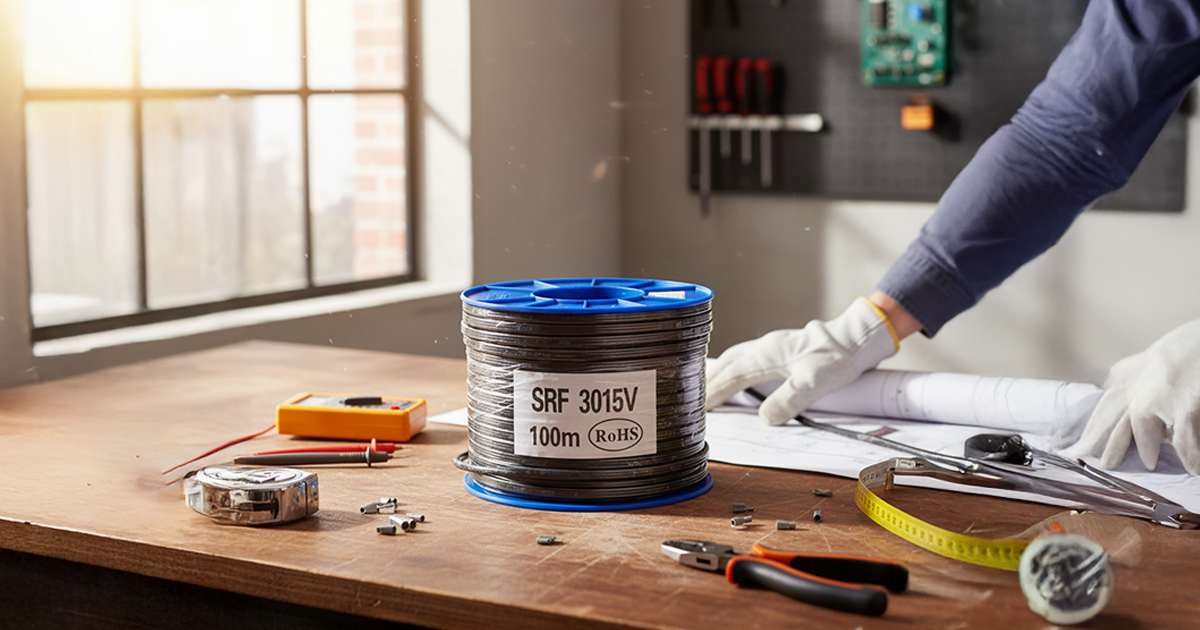
In any electrical installation across Australia, one cable remains the quiet workhorse behind every light switch, socket, and power outlet, the Twin and Earth TPS Cable.
It’s the bread-and-butter cable every sparky works with, but it’s also one that can cause no end of trouble if you get the gauge wrong, skip derating, or go cheap on the quality. As we move into 2025, understanding TPS cable specs, compliance, and buying practices has never been more important especially with changing AS/NZS 5000.2 standards and tighter inspection requirements across the states.
This blog breaks down everything electricians need to know: choosing the right size, understanding derating, avoiding common failures, and knowing when and where to buy in bulk without compromising safety or compliance.
What Exactly Is a Twin & Earth TPS Cable?
Let’s start with the basics.
A twin and earth TPS (Thermoplastic Sheathed) cable contains two insulated active and neutral conductors (the “twin”) and a bare earth conductor. It’s typically used for fixed wiring in domestic, commercial, and light industrial applications essentially anywhere you need a reliable, insulated cable that handles Australian conditions.
The outer PVC sheath offers mechanical protection, UV resistance, and flexibility during installation, which makes it perfect for running through walls, ceilings, or conduits.
But here’s where things get critical: not all TPS cables are created equal. The type, gauge, and compliance markings can vary drastically between brands, and these differences can make or break a job’s safety and performance.
The Role of Gauge Why Size Matters
When it comes to twin and earth TPS cable, size isn’t just about how it looks, it's about how much current it can safely carry.
Here’s a quick refresher on the most common sizes:
Cable Size | Typical Use | Max Current (approx.) |
1.5mm² | Lighting circuits | ~10 amps |
2.5mm² | Power outlets, general use | ~20 amps |
4.0mm² | High-demand appliances (e.g., ovens, air conditioners) | ~25–30 amps |
6.0mm²+ | Submains, heavy-duty loads | ~40 amps and above |
The 2.5mm TPS remains the most commonly used in residential work. It’s the go-to for general power circuits robust enough to handle everyday loads while still easy to strip and terminate.
However, underestimating current demands or failing to consider derating (temperature, grouping, or installation method) can lead to overheating, insulation damage, and premature cable failure.
Derating: The Detail That Too Many Forget
Even experienced electricians can sometimes overlook derating factors — and that’s where many TPS cable issues begin.
Derating means adjusting the cable’s current-carrying capacity based on environmental and installation conditions.
Here’s what to keep an eye on:
- Ambient temperature: Higher temps reduce current capacity. In ceiling cavities during summer, a 2.5mm TPS cable might need derating if insulation surrounds it.
- Cable grouping: When multiple cables run together in a conduit or trunking, heat buildup increases reducing efficiency.
- Installation method: A cable clipped directly to a wall dissipates heat better than one buried in insulation.
- Voltage drop: Long runs mean more resistance. Always check voltage drop limits under AS/NZS 5000.2, especially in large homes or long feeder circuits.
The rule of thumb? Always check your derating tables before finalising cable size — what’s safe in open air might not be compliant in an insulated ceiling.
Common Twin & Earth Cable Failures (and How to Avoid Them)
Even when the cable is rated correctly, installation or quality issues can still cause problems. Below are the most common issues seen in the field:
1. Poor Terminations
Loose or over-tightened screws can cause arcing and eventual insulation damage. Always ensure terminals are clean, correctly torqued, and that conductor strands are intact.
2. Sheath Damage During Installation
Dragging cable through rough studs or across sharp edges can nick the PVC sheath. Always use smooth entry points or bushings in metal conduits.
3. Mixing Non-Compliant Cables
There are still imported TPS cables floating around that don’t meet AS/NZS 5000.2. These often have thinner insulation, undersized conductors, or poor UV resistance.
4. Excessive Heat or Overloading
Running too many loads on a circuit wired with smaller gauge cable can lead to early insulation breakdown.
5. Incorrect Colour Coding
Though most modern TPS cables follow the Australian colour standards, older stock or overseas imports might not. Double-check before connecting never assume colour equals compliance.
A bit of diligence here can save a lot of rework, and possibly prevent a major safety hazard.
Understanding AS/NZS 5000.2 Compliance in 2025
If you’re working with TPS cable in Australia, AS/NZS 5000.2 is your go-to standard. It outlines construction, testing, and performance requirements for low-voltage flexible and fixed wiring cables.
Here are a few compliance points worth remembering:
- Markings: Every compliant cable must have printed markings showing conductor size, voltage rating (usually 450/750V), manufacturer ID, and AS/NZS 5000.2 reference.
- Conductor quality: Only high-purity copper is acceptable. Aluminium-core or mixed-metal options are not compliant for standard TPS.
- Insulation: PVC sheathing must meet specified thickness and heat-resistance standards.
- Testing: Cables must undergo insulation resistance and tensile strength testing before approval.
If you’re ever in doubt, check for Regulatory Compliance Mark (RCM) or a valid Certificate of Conformity from an accredited supplier.
In short: if it doesn’t show AS/NZS 5000.2, don’t install it.
Buy-Right Checklist for Twin & Earth TPS Cable
When sourcing TPS cables especially in bulk a few simple checks can help you avoid compliance headaches later:
Confirm compliance: Check for AS/NZS 5000.2 markings and RCM logo. Inspect the sheath: Look for smooth, consistent insulation with no cracks or uneven thickness. Measure conductor gauge: Don’t rely on printed size confirm with calipers if in doubt. Buy from reputable suppliers: Stick with trusted Australian wholesalers with a solid trade reputation. Avoid suspiciously cheap imports: If the price seems too good to be true, it probably is. Ask about temperature ratings: Some premium brands offer heat-rated options for high-ambient installs.
You wouldn’t install a budget breaker on a high-load circuit so don’t gamble on low-quality cable either.
Bulk-Buying Twin & Earth TPS Cable Smart Trade Tips
If you’re running a busy electrical business, bulk-buying TPS cable can save serious dollars over the course of a year. But not every “bulk” deal is a good deal.
Here’s how to do it right:
Compare by length and quality, not just price per roll Some cheaper rolls are shorter or use thinner copper conductors. Always check the total length and core spec.
Plan ahead for seasonal demand Prices can spike during peak construction months. Buying ahead of schedule saves money and ensures supply.
Ask about volume discounts Reputable wholesalers like AGM Electrical Supplies often provide trade-tier pricing for electricians purchasing multiple rolls.
Store properly Keep rolls off the ground and away from direct sunlight. Prolonged UV exposure can stiffen PVC sheathing over time.
Stay consistent with your brand Using the same manufacturer across jobs reduces variation in sheath flexibility, core colour, and insulation behaviour small details that make your installs neater and more predictable.
Why the Right Cable Choice Matters in 2025
With building codes tightening and energy efficiency expectations rising, every part of an electrical system down to the wiring is under more scrutiny.
A compliant, correctly rated twin and earth TPS cable ensures:
- Safer installations
- Fewer call-backs for faults or tripping
- Longer service life of connected devices
- Easier certification and inspection approval
For electricians, it’s not just about doing the job it’s about doing it once and doing it right.
Where to Source Quality Twin & Earth TPS Cable
When it comes to sourcing reliable, AS/NZS 5000.2-compliant twin and earth cables, you need a supplier that tradesmen can trust. That’s where Electrical Wholesaler by AGM Electrical Supplies comes in.
AGM stocks a wide range of twin and earth TPS cables including 2.5mm TPS in various lengths and ratings, all tested for Australian conditions. Their cables are compliant, durable, and priced to support electricians working across residential, commercial, and industrial projects.
Whether you’re buying a few rolls for a job or stocking up in bulk for the month, AGM offers fast shipping, competitive trade discounts, and the kind of product reliability you can count on.
Because when it comes to wiring, every metre counts and cutting corners isn’t worth the risk.
FAQs
What is the main use of twin and earth TPS cable?
It’s primarily used for fixed domestic and commercial wiring connecting power outlets, lighting circuits, and appliances.
What size twin and earth cable is used for power outlets?
Most electricians use 2.5mm TPS cable for general power outlets, depending on the circuit length and load.
Is twin and earth TPS cable suitable for outdoor use?
Yes, but only if it’s properly protected from UV and mechanical damage for example, run through conduit when exposed.
What does AS/NZS 5000.2 compliance mean?
It means the cable has been tested and approved for Australian standards in terms of construction, safety, and performance.
Where can I buy compliant twin and earth TPS cable in Australia?
You can get it from AGM Electrical Supplies, which offers fully compliant, high-quality cables at fair trade prices.
Comments
No posts found
Recent posts
SMS, Wechat and Whatsapp Contact Details:
For quotes, orders or to get the latest product and pricing news
PLEASE NOTE: We Do Not ANSWER Phone Calls (messages only) and We only respond during business hours.-
Mobile for SMS only

-
Text Message on Whatsapp
 scan Me
scan Me -
Text Message on WeChat
 Wechat ID: agmelectrical
Wechat ID: agmelectrical scan Me
scan Me












































